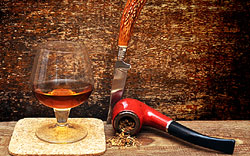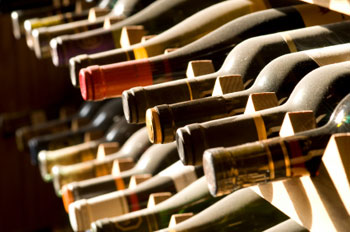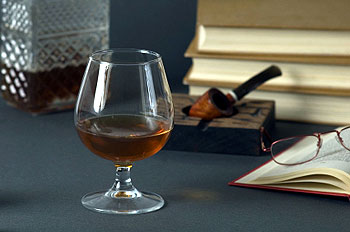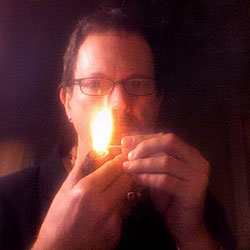By G. L. Pease
 I frequently mention wine and pipe tobacco in the same puff of smoke. It’s usually an off-hand, casual remark, and it wasn’t until I was challenged by a friend, a devotée of the grape, but no fan of the leaf, to defend what seemed to be a somewhat tenuous position that I started to examine it more closely, and wound up finding even more similarities than I’d previously thought possible. On the surface, it might be difficult to imagine two things as different as a bottle of wine and a tin of tobacco sharing many similarities; let’s start at the ground, and work our way up.
I frequently mention wine and pipe tobacco in the same puff of smoke. It’s usually an off-hand, casual remark, and it wasn’t until I was challenged by a friend, a devotée of the grape, but no fan of the leaf, to defend what seemed to be a somewhat tenuous position that I started to examine it more closely, and wound up finding even more similarities than I’d previously thought possible. On the surface, it might be difficult to imagine two things as different as a bottle of wine and a tin of tobacco sharing many similarities; let’s start at the ground, and work our way up.
Though there are many species of tobacco, quite a few of which are grown as ornamental plants for their showy leaves and fragrant flowers, that which finds its way into our pipes is of a single species, Nicotiana tabacum. (N. rustica is sometimes grown for smoking, or for the production of chewing tobacco or pesticide, but it is much to harsh and too strong to find its way into our pipes.) Similarly, the majority of grapes cultivated for the production of wine are of a single species, Vitis vinifera.
Within these respective species, however, there are many varieties, each having it’s own distinctive characteristics. With tobacco, we have, oriental, burley, Virginia flue-cured, Maryland, and Kentucky varieties, amongst others, each with its own personality, flavor, aroma and burning qualities. In the same way, vines bring us grapes like Cabernet Sauvignon, Pinot Noir, Chardonnay, Sauvignon Blanc, Zinfandel, Syrah, and many others, each being distinctive and possessing unique characteristics of taste, aroma, and color.
 But, it doesn’t stop with the plant. In the world of wine, terroir is a term used to describe the land and conditions in which the grapes are grown – the soil, the climate, the topography of the vineyards, and even other plants that grow in the vicinity of the vines create an aspect of the finished wine that goes beyond the basic varietal characteristics of the grapes themselves. If the soil is rocky, the wine may exhibit mineralic qualities. If aromatic herbs are grown nearby, the wine will take on some of those aromas. A vine grown on a eastern slope with sunny mornings will produce a very different wine than the same vine grown on an western slope and getting more of its sunlight in the afternoons.
But, it doesn’t stop with the plant. In the world of wine, terroir is a term used to describe the land and conditions in which the grapes are grown – the soil, the climate, the topography of the vineyards, and even other plants that grow in the vicinity of the vines create an aspect of the finished wine that goes beyond the basic varietal characteristics of the grapes themselves. If the soil is rocky, the wine may exhibit mineralic qualities. If aromatic herbs are grown nearby, the wine will take on some of those aromas. A vine grown on a eastern slope with sunny mornings will produce a very different wine than the same vine grown on an western slope and getting more of its sunlight in the afternoons.
Tobacco can also exhibit terroir, though usually not in as obvious a manner. Soil, climate, irrigation and cultivation techniques, when combined with the tobacco’s genetic stock, affect the leaf’s nicotine level, sugar and acid content, aroma, flavor, and burning qualities. A burley plant raised in the rich, fertile soil of the Carolinas, for instance, will yield a very different leaf from the same plant reared in Brazil. Flue-cured tobaccos from the south of France, most often robed in a bright golden straw color, are mild, slightly tart, with wonderful sweetness, while the same leaf grown in Malawi tends to be darker, stronger more oily, and less sweet. Each style has its place, and some blending houses show preference for one style over another, using their preferred leaf to its best advantage.
Turning our attention to the path from raw ingredient, grapes or tobacco leaf, to finished product, we can also find some interesting parallels, both in method and approach. Some wine makers, especially the larger, mass-producers of bulk wines, will assert a specific style upon what they make, blending grapes from different vintages, different estates, even different varieties, and using vinification techniques designed to lend greater consistency to what ends up in the bottle. These wines can be of good quality, and will taste very similar from year to year, but they’re never going to be gold medal winners.
 Others will use all of their skills and experience to let exceptional grapes express themselves with a purer voice. This is the approach most often taken by the best vintners, frequently making wines from the grapes of a single estate, or even a single plot. These wines will change from vintage to vintage, and there have been years in which some producers were unable, or unwilling, to make a wine because weather conditions resulted in an inferior harvest.
Others will use all of their skills and experience to let exceptional grapes express themselves with a purer voice. This is the approach most often taken by the best vintners, frequently making wines from the grapes of a single estate, or even a single plot. These wines will change from vintage to vintage, and there have been years in which some producers were unable, or unwilling, to make a wine because weather conditions resulted in an inferior harvest.
Most of the big pipe-tobacco operations (and virtually all of the cigarette companies) tend to operate more similarly to the bulk wine producers, striving to manufacture as consistent a product as possible by blending different crops and using sugars and flavoring agents to make final adjustments. Smaller blending houses seek out the best possible leaf, and endeavor to create the best blend possible from that leaf, consistent with the style of the blend being produced. (See last month’s column, Hobgoblins of Consistency, for more.) Working this way, one vintage of a particular blend might be slightly different from another, but they’ll show sufficient stylistic similarity to make even the astutely critical smoker happy. Some blending houses go so far as to package limited edition, single-vintage tobaccos produced from a specific crop with exceptional characteristics.
Leaving the mass-market products aside, and turning our attention only to premium wines and tobaccos, let’s look at aging. Like fine wines, the best tobaccos improve with time in their tins. And, also like wines, different blends have different life-expectancies before they go "over the hill." Biological and chemical processes begin to take place as soon as a tobacco is tinned, and the changes can be dramatic, depending on the blend itself, how long it’s left to sit, and the conditions under which it’s aged. Ideally, tins or jars of tobacco and bottles of wines should both be stored in a cool, dark, relatively dry (ca. 60% R.H.) place.
 The most noticeable changes occur within the first few months, with 12 to 18 months representing a good starting point for those new to experiencing aged tobaccos, though changes are very detectable after about six months. At about five to six years, real magic often takes place, with the tobacco exhibiting greater complexity and smoothness, and often tasting and smelling quite different from its younger form.
The most noticeable changes occur within the first few months, with 12 to 18 months representing a good starting point for those new to experiencing aged tobaccos, though changes are very detectable after about six months. At about five to six years, real magic often takes place, with the tobacco exhibiting greater complexity and smoothness, and often tasting and smelling quite different from its younger form.
As with great wines, whose corks can fail in the bottle, aging tobacco doesn’t always go the way we want it to;. seals can break and tins can rust, or, in extreme cases, mold can develop. Here, we’re a little better off than the wine collector. While a failed cork guarantees a ruined wine whose destiny it is to be poured down the drain, a broken seal or pin-holed tin doesn’t necessarily ruin the contents, though we may be robbed of some of the wonderful byproducts of the long aging. Frequently, the tobacco can be carefully removed and rehydrated, and will deliver an excellent smoke. (Mold, on the other hand, is disastrous, though fortunately relatively rare.)
Different tobaccos, like different wines, have different life expectancies, too; it really depends on the blend, and what our expectations are from it. A tobacco or a wine with good structure – that quality that allows it to stand up to the years – can go decades before beginning a slow decline, while one that lacks body in its youth will just get weak. Some feel that Latakia blends, particularly those blends that rely on the youthful exuberance of that leaf for their character, begin to go too soft after a few years, and can become flat, while virginia blends are almost universally accepted as worthy of long-age. (I’ve smoked some virginias and virginia/perique blends in excess of 60 years old that were sublime, showing no sign of being beyond their prime.) And, while Latakia blends do soften over time, they also develop new complexity and wonderful aromas that, if you’re willing to forgo the campfire and leather intensity of young Latakia, can be delightful in their own rights.
 Just as a great wine opens in the glass, allowing some of the off-flavors of age to dissipate to the air, and gradually offering up deeper aromas, tobaccos with even a little age under their belts are often improved by being allowed to breathe a bit. Though there is nothing more enjoyable to me than that first whiff, and the first bowl from a long-aged tin, over the years, I’ve learnt to anticipate that, in fact, the last bowl is often even better than the first, especially if stored in a jar with a little head space, because the tobacco has had some time to breathe.
Just as a great wine opens in the glass, allowing some of the off-flavors of age to dissipate to the air, and gradually offering up deeper aromas, tobaccos with even a little age under their belts are often improved by being allowed to breathe a bit. Though there is nothing more enjoyable to me than that first whiff, and the first bowl from a long-aged tin, over the years, I’ve learnt to anticipate that, in fact, the last bowl is often even better than the first, especially if stored in a jar with a little head space, because the tobacco has had some time to breathe.
Finally, in order to fully appreciate a wine or a tobacco, the right vessel must be used. A great wine in a paper cup certainly won’t show its best, and a great tobacco in a bad pipe isn’t likely to be a particularly enjoyable experience. Taking some time to explore a tobacco in different pipes often provides some wonderful surprises, and once in a while, we find those special combinations that deliver the sort of smoke we never forget. To this day, I can easily recall a bowl of ten year old Drucquer Red Lion that I smoked out of an especially lovely Barling Quaint that belonged to a friend and fellow collector, and that was nearly 30 years ago!
We’ve only scratched the surface, here; this is a weightier subject than can be treated fully in a short column. We could go into comparisons of specific wine types with specific tobaccos, or how tobaccos enhance other gustatory experiences, and vice versa, or things I’ve not thought of, yet. I hope, however, that there’s been some drink-for-thought in these brief words, and that this might stimulate some readers to dive into the deep waters to explore more fully on their own. Exploration is, after all, a big part of the enjoyment of our pastime.
Your turn.
-glp

Since 1999, Gregory L. Pease has been the principal alchemist behind the blends of G.L. Pease Artisanal Tobaccos. He’s been a passionate pipeman since his university days, having cut his pipe teeth at the now extinct Drucquer & Sons Tobacconist in Berkeley, California. Greg is also author of The Briar & Leaf Chronicles, a photographer, recovering computer scientist, sometimes chef, and creator of The Epicure’s Asylum. |
[Editor’s Note: If you’d like to read more about wine, check out our Wine Column.]
















Great article..as per usual Mr. Pease!!!
Fantastic analogies…
Great article as always, Greg. I would add that coffees and teas take their place with these gustatory experiences that reflect the complex interactions of grape, leaf, or bean with our palates; fleeting moments that a life spent capturing would not be considered wasted.
Thank you, gents. And, I agree about tea and coffee being equally in their place here, and, even some fine spirits!
Thank you Greg.
That was a great read.
I’ll re-read it later this evening with a bowl or two of Haddo’s Delight and a dusty old cob-webby bottle of wine.
This post is simply stunning! I love tobacco almost as much as I love wine. 😉 Now I need a glass of Chambourcin.
I also find it interesting that the same things that will ruin a bottle of wine or a tin of tobacco, especially the mold, are the same things that will ruin a book. We must be kind and gentle servants to our earthly pleasures.
Another great article, Greg!
G.L. Please. He’s not just a master blender, but a master writer.
I kid you not, I’d buy a book if G.L. Please wrote one.
As a bit of a brewer myself, I often find comparisons between fermented beverages and tobacco. Thank you for the thoughts Mr. Pease!
This article has been waiting to be written for a long time and was prologued in the “….Consistency” thread; excellent precis of what could be a doctoral dissertation!
A couple of thoughts:
“Different tobaccos, like different wines, have different life expectancies, too; it really depends on the blend, and what our expectations are from it. A tobacco or a wine with good structure – that quality that allows it to stand up to the years – can go decades before beginning a slow decline, while one that lacks body in its youth will just get weak….”
Wines with really good structure not only benefit from aging but must be aged as the structure would be too firm for immediate drinking; is this so with tobacco blends?
Wines without quality do not benefit from aging (age crap and you get old crap); is this too applicable to tobacco’s?
The terroir question is crucial to wine and tobacco but some also say it’s the most important factor in choosing good briar.
“While a failed cork guarantees a ruined wine whose destiny it is to be poured down the drain….”
I bet it goes into your cooking pot – mine does!
“….the last bowl is often even better than the first, especially if stored in a jar with a little head space, because the tobacco has had some time to breathe)”
How often the last glass is the best (or, indeed, the only good one) if the wine hasn’t been aired long enough!
The wine and tobacco pairings is a different subject; more research is needed over many bottles and many bowls!.
Is that a Sanda pipe in the picture? Fail. Haha great article though!
Thanks for another great article that hits most of the major parallels between two epicurean experiences; and suggests yet another article examining exactly how they might intersect, or be enjoyed together. Your mention of terroir also reminds me that the vocabulary of oenology may prove useful when applied to tobacco (which was touched upon in “Don’t Think Of A Purple Giraffe.”
.
I was particularly taken by your recognition of the importance of pairing wine to glass and blend to pipe — both presumably driven by geometry; this, while discovering just how successfully one of my under-used bulldogs tamed one of the sharper Va.’s in my cellar.
.
Thanks for delivering much to think about and experience. 🙂
Jim wrote: “Wines with really good structure not only benefit from aging but must be aged as the structure would be too firm for immediate drinking; is this so with tobacco blends? Wines without quality do not benefit from aging (age crap and you get old crap); is this too applicable to tobacco’s?”
While a well-structured wine won’t be as fully enjoyable in its youth, it won’t be bad, per se. I suppose the parallel doesn’t quite hold, though, as a great tobacco blend should taste good right out of the gate. It won’t have developed its complexity, and may be somewhat out of balance, but it shouldn’t taste bad. And, personally, I think poor blends are just like poor wines in the respect that aging will not transform them into something wonderful.
“The terroir question is crucial to wine and tobacco but some also say it’s the most important factor in choosing good briar.”
I’m of the belief that the terroir of the briar may play a role, but it’s not as significant as some would have us think. How the briar is handled after digging, how it’s cut, boiled, cured, aged, and where it’s aged, all play a role in the smoking qualities of the finished pipe. Then, there’s that little bit of something inexplicable that makes the difference between a good pipe and an exquisite pipe.
“The wine and tobacco pairings is a different subject; more research is needed over many bottles and many bowls!”
Agreed! Salut!
Cortezattic writes: “I was particularly taken by your recognition of the importance of pairing wine to glass and blend to pipe — both presumably driven by geometry; this, while discovering just how successfully one of my under-used bulldogs tamed one of the sharper Va.’s in my cellar”
While glass geometry is an important factor for tasting wines, the fact that glass is completely neutral, and briar, much less so results in a significant deviation in the analogy. Frankly, the taste of a specific pipe with a specific tobacco is not something that can be predicted with any accuracy using any sort of metric. I’ve got pipes of all shapes and sizes, many exhibiting a preference for one style of blend, or even a single blend. Sometimes, it’s a subtle thing, sometimes a dramatic one. But, when that special combination reveals itself, I’m not going to argue about why; I’m just going to enjoy it for as long as it lasts. (I first stumbled upon the way virginias bloom in pots quite accidentally, by eschewing the conventional wisdom that “pots are not flake pipes.” Why not? So, I tried it, and found it fantastic. I love full Latakia blends in smaller pipes, because they can intensify to the point of palate fatigue in larger pipes to me. Different pipes, different tobaccos, different folks. That’s all there is to it.
Very nice analogy between the aging of wine and tobacco. Personally, Coffee or a spirit would be my choice for pairing with tobacco. Wine with food.Different strokes for different folks as they say.
Doc, I totally agree. In fact, I’ve been banging my head trying to figure out if there is ANY way that a wine/tobacco pairing could be done. As for wine with food, how about wine as food. During the ridiculousness that was going on in California during the 1980s, the term “food wine” was coined, which I always considered ludicrous. Fortunately, most vintners have gotten smarter, and understand that wine is supposed to go with food, so the term is redundant. (I’m nearly as opinionated about wines, spirits and food as I am about tobacco!)
Some beers are certainly sturdy enough to stand up to a good tobacco. In fact, I think the problem might be finding tobaccos that stand up to the beers! A California style IPA with JackKnife might be a good starting point. Perhaps a nice Belgian with a VA/perique blend, or a Heffeweizen with a pure VA. An ESB might make a nice pairing with a medium Latakia blend, a dry Stout with something heavy, and a malty Scottish style with a burley blend. There might be something there!
Cheers,
-glp
I agree with Doc’s & GLP’s pairing comments. I’ve found that a smoky, peaty lowlands single malt or a blend like Johnny Walker Black or Chivas works well with the VA/VAPER blends I like but, oddly enough, not so much with latakia-heavy blends. I’ve found that Irish and Canadian whiskeys are, at least for me, a much better complement to the latter.